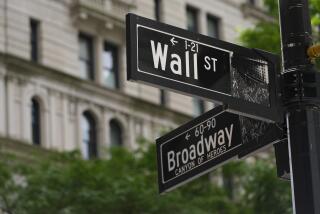How ‘safe’ do you have to feel to take some risk with your money?
- Share via
Here’s a modest proposal for getting the White House and Congress to agree on a plan to slash the federal budget deficit: Have Wall Street’s biggest banks engineer a one-day drop of, say, 800 points or so in the Dow Jones industrial average.
Forget that “flash-crash” computer-driven stuff from May 6, 2010, when the Dow fell nearly 1,000 points intraday only to recoup most of the loss by the end of trading.
To scare Washington we need a crash that extends all the way to the closing bell, threatening lawmakers’ personal stock investments — not to mention financial-industry campaign contributions.
Remember how this worked during the financial meltdown of fall 2008? The Dow plummeted 777 points on Sept. 29 that year after the House shocked the Bush administration by rejecting its $700-billion bank bailout proposal, the Troubled Asset Relief Program.
By the end of that week, amid a torrent of predictions that Armageddon was nigh, the House reversed itself and TARP became law.
Of course, a version of Armageddon arrived anyway as markets resumed their plunge in October and the recession deepened. But TARP’s backers say it all would have been far worse without that rescue. We’ll never know for sure.
If some entity needs to play the enforcer with Washington this time around, it may again have to be stocks. Because bond investors clearly aren’t going to do it.
For the last two years, a widespread assumption on Wall Street has been that bond buyers would eventually force the federal government to rein in the ballooning deficit by demanding ever-higher interest rates on Treasury securities.
Instead, money has been pouring into Treasuries once again this year, driving bond yields to their lowest levels since last fall. A 10-year T-note now pays 2.87% in annual interest, far less than the 3.69% the government had to pay to issue bonds of that maturity two years ago — and $2.6 trillion of deficit spending ago.
In Europe, meanwhile, bond investors have pushed yields on government bonds of deficit-plagued Greece, Ireland and Portugal well into double digits, forcing all three countries to seek bailouts from the rest of the continent. With market yields on Greece’s two-year bonds at 28%, making private borrowing all but impossible, the country is back for Bailout II from the European Union.
The U.S. Treasury bond market has, once again, been a beneficiary of other markets’ woes. Good thing for Uncle Sam that much of the world still considers Treasury debt to be a haven, given how far apart the White House and Republican leaders remain on how to bring down the deficit.
It’s true that the Federal Reserve has been a big help to the Treasury this year, buying $600 billion of bonds since November. But even as the Fed gets set to wrap up those purchases by June 30, the market shows no sign of lacking demand from private investors who are spooked by Europe’s debt troubles and by the stumbling global economy.
What’s good for Treasuries often is not so for the stock market and other higher-risk assets, and that has been the case for the last two months. The Dow industrial average lost 115 points Friday to 11,934. The Dow eased 0.6% for the week and is down 6.8% from its multiyear high reached April 29.
Yet there may be a silver lining for the equity market with so many people loaded with Treasury bonds and other high-quality debt, such as corporate issues: The safer investors feel because of the bond portion of their portfolios, the less likely they may be to bail on whatever they have left in stocks.
Bonds are much more significant as a component of many investors’ portfolios than before the financial crisis began in 2007.
Case in point: Millionaire investors worldwide now have 29% of their assets overall in bonds, up from 21% in 2006, according to an annual survey of the wealthy by consulting firm Capgemini and Merrill Lynch. The stock portion of millionaires’ holdings also has risen, but marginally — to 33% now from 31% in 2006. (The rest of the assets are in real estate, alternative investments and cash.)
Bond investments all have the hypothetical risk of principal loss because prices of the securities drop if market interest rates rise. Yet many investors in high-quality bonds don’t know what it is to lose money in fixed-income investments, at least on a calendar-year basis.
The Vanguard Total Bond Market Index fund, for example, hasn’t had a losing year since 1999. Interest earnings have more than made up for any principal losses each year since then.
This year the fund was slightly in the red in January and February as interest rates rose, but the spring plunge in rates has pushed the portfolio to a 3.6% year-to-date total return as older bonds have appreciated in value.
By contrast, the Vanguard 500 Index fund, which tracks the Standard & Poor’s 500 stock index, is up just 1.7% this year as the equity market’s gains have evaporated.
As popular as bonds remain, investors who want absolute safety for their money are sticking with cash. Lots of cash.
Since 2008, millions of individuals and corporate investors have sharply boosted what they hold in cash accounts at banks. The total in basic savings and money market deposit accounts has reached a record $5.58 trillion, up from $5.09trillion a year ago and $4.03 trillion three years ago, according to Federal Reserve data.
There’s an additional $2.7trillion sitting in money market mutual funds.
Most of the combined $8.3 trillion in those cash accounts is earning close to zero interest. That’s a massive chunk of capital producing almost no return for its owners. To put it in perspective, the sum in cash accounts is 52% of the value of the entire U.S. stock market as measured by the Wilshire 5,000 index.
But the idea of “absolute safety” in cash is a misnomer. Your principal is safe in a federally insured bank account, but its value is eroded by inflation. And as anyone who drives or eats knows, inflation has jumped over the last year.
The consumer price index was up 3.6% in May from a year earlier, three times the rate of increase seven months ago.
That isn’t going to sway any investor who fears double-digit losses in stocks to move cash to the equity market. But it’s a reminder that, with the Federal Reserve likely to keep holding short-term interest rates near zero into 2012, and with inflation rising, cash is a depreciating asset.
Though the struggling stock market is again unloved, investors who have hefty stakes in cash and bonds should remember why stocks still belong in most diversified portfolios: As the last two years demonstrated, equities can provide the payoff if things turn out better than you’d feared.
More to Read
Inside the business of entertainment
The Wide Shot brings you news, analysis and insights on everything from streaming wars to production — and what it all means for the future.
You may occasionally receive promotional content from the Los Angeles Times.










